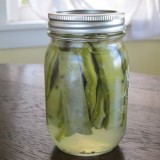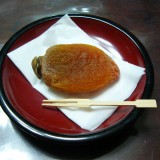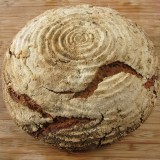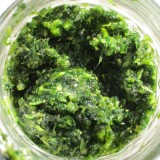
Dried corn on the left, parched corn with peas and blueberries on right
I was thinking about trail food, and wishing for a portable snack which was not based on nuts and chocolate chips (though there’s nothing wrong with that!) or too sugary, like dried fruit or energy bars. Then I recalled parched corn.
Parched corn–dried corn which has been roasted–is one of those legendary Native American foods, like pemmican, which you hear about but don’t necessarily ever get to try. Parched corn is a lightweight, long-keeping, high-energy trail food. It can also be ground into flour and used in cooking. I have vague elementary school memories of claims that a warrior* could walk a whole day nourished on just a handful of parched corn.
(They did not mention that the warrior might be cranky at the end of the day–which I suspected might be the case. I’ve heard similar claims about Roman soldiers marching on handfuls of barley. Poor guys. But now that I’ve tried parched corn, I must admit that it is strangely filling. I managed to spoil my supper by doing too much tasting as I roasted the corn. So maybe the claim are real and–geek alert!– parched corn is our homegrown Lembas bread.)
Parched corn, being tasty and useful, was widely adopted by the Europeans who arrived here. So it was turned out to be the Official Snack Food of wagon trains and trappers and the like.
I went looking for a recipe and found my idea was hardly original. Preppers and outdoorstypes love their parched corn and there are plenty of recipes and tips out there. The only thing that I have to offer that is different is that this is a rather sissified, citified, consumerist version of parched corn. And it is delicious. Chewy, sweet, a little salty… and most of all, corny.
Some technical details, before we start:
See, real parched corn should be made by stripping the whole dried kernels off of dried ears of especially bred parching corn. Corn you’ve grown yourself, of course. Parching corn is bred for good flavor and soft texture, and the red breeds are supposed to be the very best. Though it seems that if you’re not particular, and your dental work is sturdy, you could try to just about any dried corn. I saw accounts from prepper guys who use feed corn. But I’d draw the line at popcorn. I think that really would break your teeth.
It would be lovely to grow heirloom corn and make this from scratch, but Erik and I don’t really have enough room, unless we’d like to only grow corn and nothing else. And LA isn’t exactly corn country, so I don’t have high hopes of finding a source of dry parching corn. So I did what any Angelino would do — I drove to Trader Joes and bought a three bags of frozen corn nibblets. Then I put the nibblets in our fancy electric dehydrator. I dried a bag of baby green peas while I was at it, because I thought they might parch nicely, too.
Fresh frozen corn is, obviously, very different than dried-on-the-cob corn. The fresh kernels are sliced off the cob, so they are open ended. They are missing the white part, the germ. Whole dried corn kernels will look more like popcorn kernels. And as they are whole, they act a little like popcorn in the cooking–they swell and crack and even pop sometimes. Citified parched corn made from frozen corn will not do this. It looks different. But it’s still tasty.
The recipe, such as it is:
Parched corn is just toasted dried corn. You toast it by tossing it in a hot skillet. Nothing could be simpler. There are only a couple of variables you need to decide on.
- The first is the raging oil or no oil controversy that exists among parchers. It’s not a deep fried product by any means, but some folks like putting a little oil in the pan. Maybe it helps spices stick? Purists insist that there should be no oil. I used no oil.
- The second is flavoring. Parched corn doesn’t really need flavoring–it’s good on its own. Salt, of course, only makes it better. But it can take as many types of seasoning as popcorn, from sweet to spicy to savory. You just throw spices into the pan to roast with the corn. I’ve also seen recipes where someone will roast the corn in a pan then toss it with a flavor mix (perhaps something suspiciously like what you’d use on Chex mix) and then heat it again in a low oven to glue the spices to the corn.
- I’ll note that after seeing one recipe where the guy put brown sugar on his corn, I tried a small batch with sugar. Burnt sugar + toasty corn = crack cocaine. I opted not to make all my corn that way, or I’d eat all of it in a sitting, Lembas effect or not.
Okay, really, here’s the how-to:
Start by dehydrating your frozen corn by the method of your choice. I just spread frozen corn out on the trays and let the dehydrator do the defrosting. If you don’t have a dehydrator, you may be able to do this in your oven, if your oven has a very low setting.
Preheat a big heavy skillet or a wok over a low flame. It’s surprising how little heat you need to brown these babies. Add a smidge of oil if you want. Cover the bottom of the pan with a single layer of dried corn. Sprinkle in some salt, spice or sugar if you like. I just used a little salt.
Shake or stir the skillet pretty constantly, as you would for popcorn, so the corn gets toasted on all sides. It happens fast. Do not leave the stove! These citified nibblets won’t swell and crack like whole corn, but they will dance a little in the pan. Take the corn to a nice toasty golden brown, dump that batch into a bowl that you’ve got waiting next to the stove and start the next batch. It’s a fast, easy process.
Blueberries!
After I was done, I realized I had about a cup of dried blueberries on hand– berries I dried, not the more sugary store-bought kind. I taste-tested a blueberry corn combo, and I am here to tell you that blueberries and parched corn are good friends. Very good friends, if you know what I mean. Think blueberry cornbread. I’d already parched some peas with my corn, for variety, but I added the blueberries anyway. “Peas, Corn and Blueberries” sounds a little strange, but it’s good. Plain corn and blueberries would be more elegant. I’m going to do that for the next batch.
* I’m old, so the way we talked about Native Americans in elementary school was pretty romanticized.





I’ve been into roasted chickpeas lately.. Take cooked or canned chickpeas, toss them will oil and seasoning, then put them on a cookie sheet in the oven at 200 degrees for 1 hour, stirring occasionally. Seasonings I’ve used recently are BBQ sauce and chili lime powder.
They are good to have around for a protein boost.
Oh yes. Roasted/Toasted chickpeas are good. I usually just toss them with a bit of oil & cumin, maybe a touch of salt.
I have to try this again. The last batch I made was…kinda weird. I can’t remember the details, but I’ll give it another shot with your cooking instructions.
Interesting…I just might have to give this a try…
Very interesting. 🙂 Thanks for sharing. We buy way too many snacks for our little boys, I wonder if they would like parched corn….
I just dehydrate whole corn cobs and then pop off the kernals as craved. Its one of my favorite foods. Super sweet.
I didn’t think about putting whole cobs in the dehydrator–seemed inefficient. But you’d get the whole kernel, so the true parched corn experience. hmmm….. And I agree, plain ol’ dried corn is tasty.
I really appreciate the humor, history and general attitude behind this post on parched corn. I’m going to try drying fresh corn and parching. I think it would be great to serve guests at my farm-style B&B, probably as a snack when they arrive.